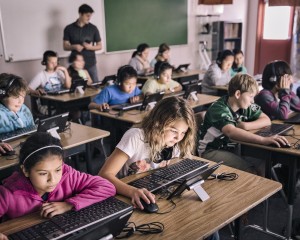If you’re thumbing through the Oct. 20 issue of TIME Magazine you might recognize a fellow Deacon on Page 36. That’s alumnus Matthew Gudenius (’00) with his Calistoga, California, elementary school students. Theirs is not just any classroom — it’s a paperless classroom, and the article is about how this innovative young teacher is using technology.
Gudenius, who double-majored in computer science and communication, began his career as a software engineer, developing websites for Hallmark, a European travel portal and an Italian bank. In 2002 he decided to pursue something more socially meaningful and recognized that education — especially in K-12 schools — was an area “behind the times” when it came to purposeful development and integration of technology.
“I became a teacher, figuring the best way to learn the needs of classroom teaching is to experience it firsthand. I came to love the human interaction and the impact I could make as a teacher, and have been continuing in that profession ever since,” said Gudenius, who was in the first freshman class to receive ThinkPads and also participated in technology integration through the RTA (Resident Technology Advisor) and STARs (Student Technology Advisors) programs.
Now that he’s teaching he has not given up programming. The thesis for his master’s degree in educational technology involved development of speech-recognition enabled e-book reading software for primary students, and he is developing an all-in-one classroom management tool incorporating gradebooks, rubrics and behavior management into Google Drive / Google Apps for Education.
“My degrees in computer science and communication have both been invaluable for these endeavors, as well as the model WFU set in its early adoption of technology for education,” he said.
— By Cherin C. Poovey (P ’08)



